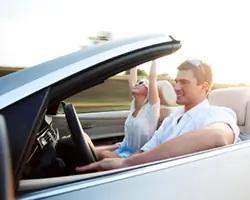Home » Vehicle Hire » Compare Car Hire » Car Hire News » Top Tips for Stress Free Car Hire – Picking up your Car

In the second of three articles, we examine the process at the car hire desk. For the first article click here.
If you haven't already got car hire excess insurance sorted, this is your last chance to buy a third party policy rather than having to pay at the desk. All car hire excess insurers insist you must have purchased the policy before taking responsibility for the car. However, if you have access to the internet, you can purchase cover while you wait in the queue.
When checking in at the car hire desk you will be expected to bring the correct documentation with you. Firstly, the rental voucher. It can be worth printing two copies so you'll still have a copy if they keep the one you hand over.
Although proof of identity requirements differ according to hire company and location, you will normally be asked for passport, driving licence (hope you got an international driving permit if it was needed) and an accepted payment method too. Some hire companies may ask for a utility bill or bank statement too particularly if you are hiring within the UK and you are a UK resident.
If your car only comes with the basic minimum legal insurance (USA/Canada/Americas) and you have purchased a third party full Collision Damage Waiver (CDW) or Supplementary Liability Insurance (SLI) policy the rental company will almost certainly want to retain a copy of the certificate to prove you are insured. You may also need a second credit card for these rentals too.
Though it is happening less than it used to, some rental company staff (particularly those on commission) will try to sell you their insurance even when you say you have your own. Knowing your policy and what is covered by it helps here. Also bear in mind that unless it is written into the contract, any additional insurance or waiver is optional so can be declined. Remember car hire excess insurance is insurance for you against being charged for damaging the rental car not an insurance for their car – they won't be making a claim you will, so whether you have it or not is nothing to do with them.
You may well be offered an upgrade at the desk. Of course, you may not want a larger car, smaller cars can make a lot of sense on smaller roads! Assuming you'd be happy with the upgraded car, are you happy with the additional cost? A few euros a day can add a lot to a fortnight's hire. It may be that they're running out of your size of car and want to move some customers up a class of car. If they do run out, they'd have to upgrade customers for free so if they can charge something for it they will. Being friendly and a bit cheeky might get you that upgrade for free.
Hopefully this won't come as a surprise if you've followed our guidance, but in some areas there are so few companies offering fair fuel policies that you may have done the sums and opted for a full to empty fuel deal.
Even if you have specifically booked a car with a full to full fuel policy, you may be offered a tank of fuel which you can return empty.
Under full to empty fuel policies you'll pay at the desk for a tankful of fuel (often at inflated rates) and return it with as little as possible.
If not already included in the hire charge, these will be payable locally.
The contract you sign at the desk is the final legally binding document covering your hire. So make sure you haven't "agreed” to take additional products or services which you didn't actually want. It has been known for excess waivers that you didn't want to mysteriously appear on the contract so check before you sign.
The first thing to check is that the car is in the same condition as recorded on the damage report. If you find anything untoward, get the damage report updated if possible. If not, at least photograph the damage.
Check the spare tyre is present (especially if it lives outside of or underneath the car) and in acceptable condition.
Check all other safety equipment (warning triangles, reflective jackets, fire extinguishers etc) has been supplied.
Check the fuel gauge is recording full or as stated in the handover paperwork.
It's often worth checking the car's language at this point and set it to your preferred language! Some might prefer having their Spanish car speaking Spanish to them to get into the local mood which is fine but if you want your messages in English, now's a good time.
Finally check you are happy with the action of the clutch to ensure it's not on its last legs. Start the car and put it into fourth gear, push down on the clutch and then let it out slowly while stepping on the accelerator. It should stall. If it doesn't when you have fully released the clutch, request a different vehicle.
Finally, if you need to return the car with a full tank, note the location of nearby fuel stations as you leave.
We use cookies and other tracking technologies to improve your browsing experience on our website, to show you personalized content and targeted ads, to analyze our website traffic, and to understand where our visitors are coming from. By browsing our website, you consent to our use of cookies and other tracking technologies.